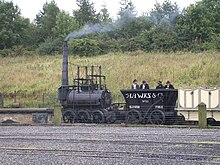Steam Elephant

Steam Elephant was an early steam locomotive from North East England.
Historiography
An illustration of the locomotive first came to modern attention in 1931[1] and it was then generally assumed to be the work of George Stephenson. More recent interpretation is based on research carried out at Beamish Museum for construction of a replica. This interpretation is based largely on contemporaneous paintings (one being the earliest known oil of a steam locomotive, by an unknown artist) and other material from the Museum archives.[2] It is from the paintings that the name Steam Elephant has become associated specifically with this locomotive.
Description and interpretation

Steam Elephant was a six-wheeled locomotive of
As with Stephenson's
It is now considered
There is evidence[2] that it was then rebuilt for use at the Hetton collieries, working there for a further decade.
Replica
Steam Elephant was recreated by
References
- ^ Appleby Miller R. N. (1931). "George Stephenson's first experiment". The Engineer. 152: 298–99.
- ^ ISBN 0-904685-08-X.
- ^ ISBN 978-0-7524-9101-1.
- ^ Tony Henderson (26 July 2013). "200-year-old railway discovered along banks of River Tyne". The Journal. Archived from the original on 1 August 2013. Retrieved 17 January 2021.
the earliest surviving example of the standard gauge railway.
- ^ a b "Excavation of waggonway in Newcastle". Heddon-on-the-Wall Local History Society. 27 July 2013.
Unlike other waggonways in the area which used a variety of gauges ranging from 3'10″ to 5'0″, that excavated at Walker was built to 4' 8".
